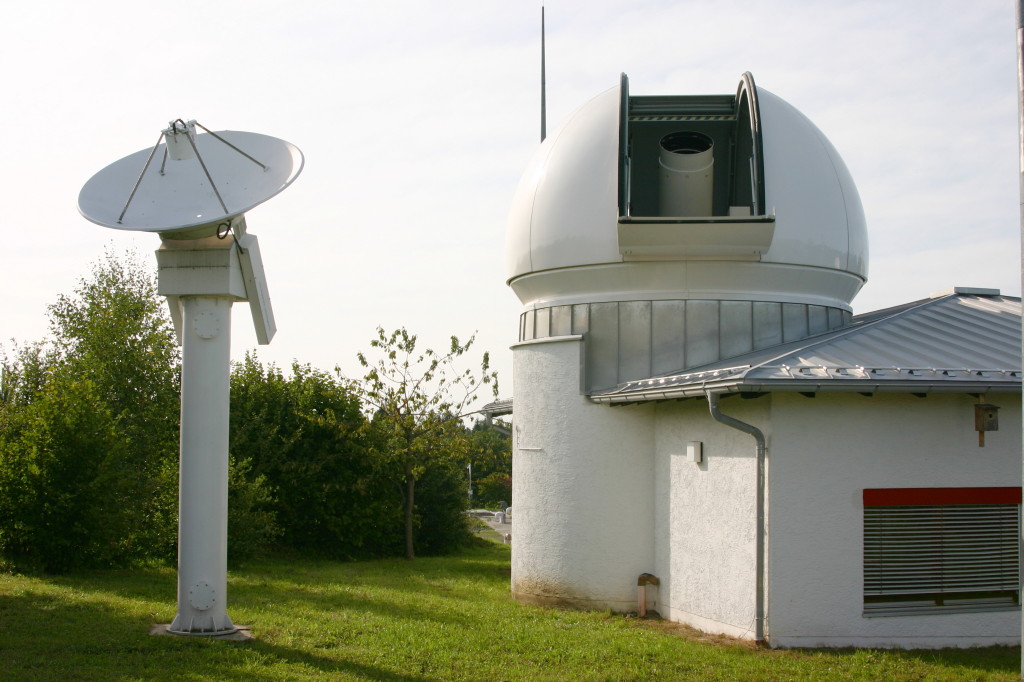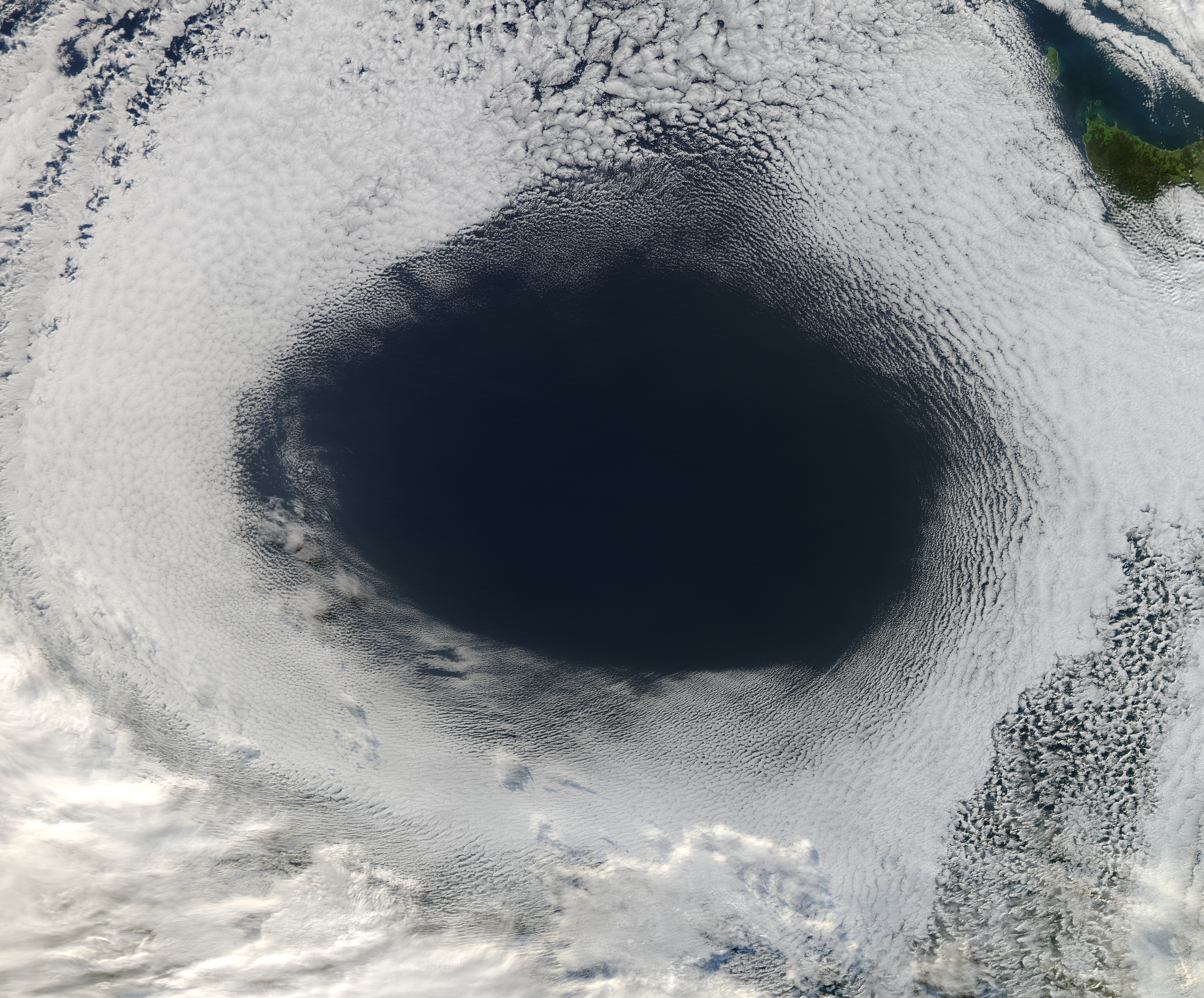|
Geostrophic Motion
In atmospheric science, geostrophic flow () is the theoretical wind that would result from an exact balance between the Coriolis force and the pressure gradient force. This condition is called '' geostrophic equilibrium'' or ''geostrophic balance'' (also known as ''geostrophy''). The geostrophic wind is directed parallel to isobars (lines of constant pressure at a given height). This balance seldom holds exactly in nature. The true wind almost always differs from the geostrophic wind due to other forces such as friction from the ground. Thus, the actual wind would equal the geostrophic wind only if there were no friction (e.g. above the atmospheric boundary layer) and the isobars were perfectly straight. Despite this, much of the atmosphere outside the tropics is close to geostrophic flow much of the time and it is a valuable first approximation. Geostrophic flow in air or water is a zero-frequency inertial wave. Origin A useful heuristic is to imagine air starting from res ... [...More Info...] [...Related Items...] OR: [Wikipedia] [Google] [Baidu] |
Atmospheric Science
Atmospheric science is the study of the Atmosphere of Earth, Earth's atmosphere and its various inner-working physical processes. Meteorology includes atmospheric chemistry and atmospheric physics with a major focus on weather forecasting. Climatology is the study of atmospheric conditions over timescales longer than those of weather, weather, focusing on average climate conditions and their climate variability and change, variability over time. Aeronomy is the study of the upper layers of the atmosphere, where dissociation (chemistry), dissociation and ionization are important. Atmospheric science has been extended to the field of planetary science and the study of the atmospheres of the planets and natural satellites of the Solar System. Experimental instruments used in atmospheric science include satellites, rocketsondes, radiosondes, weather balloons, radars, and lasers. The term aerology (from Ancient Greek, Greek ἀήρ, ''aēr'', "air"; and -λογία, ''-logy, -logia'' ... [...More Info...] [...Related Items...] OR: [Wikipedia] [Google] [Baidu] |
Standard Gravity
The standard acceleration of gravity or standard acceleration of free fall, often called simply standard gravity and denoted by or , is the nominal gravitational acceleration of an object in a vacuum near the surface of the Earth. It is a constant defined by standard as . This value was established by the third General Conference on Weights and Measures (1901, CR 70) and used to define the standard weight of an object as the product of its mass and this nominal acceleration. The acceleration of a body near the surface of the Earth is due to the combined effects of gravity and centrifugal acceleration from the rotation of the Earth (but the latter is small enough to be negligible for most purposes); the total (the apparent gravity) is about 0.5% greater at the poles than at the Equator. Although the symbol is sometimes used for standard gravity, (without a suffix) can also mean the local acceleration due to local gravity and centrifugal acceleration, which varies depending on on ... [...More Info...] [...Related Items...] OR: [Wikipedia] [Google] [Baidu] |
Newton's Second Law
Newton's laws of motion are three physical laws that describe the relationship between the motion of an object and the forces acting on it. These laws, which provide the basis for Newtonian mechanics, can be paraphrased as follows: # A body remains at rest, or in motion at a constant speed in a straight line, unless it is acted upon by a force. # At any instant of time, the net force on a body is equal to the body's acceleration multiplied by its mass or, equivalently, the rate at which the body's momentum is changing with time. # If two bodies exert forces on each other, these forces have the same magnitude but opposite directions. The three laws of motion were first stated by Isaac Newton in his ''Philosophiæ Naturalis Principia Mathematica'' (''Mathematical Principles of Natural Philosophy''), originally published in 1687. Newton used them to investigate and explain the motion of many physical objects and systems. In the time since Newton, new insights, especially around t ... [...More Info...] [...Related Items...] OR: [Wikipedia] [Google] [Baidu] |
Quasi-geostrophic Equations
While geostrophic motion refers to the wind that would result from an exact balance between the Coriolis force and horizontal pressure-gradient forces, quasi-geostrophic (QG) motion refers to flows where the Coriolis force and pressure gradient forces are ''almost'' in balance, but with inertia also having an effect. Origin Atmospheric and oceanographic flows take place over horizontal length scales which are very large compared to their vertical length scale, and so they can be described using the shallow water equations. The Rossby number is a dimensionless number which characterises the strength of inertia compared to the strength of the Coriolis force. The quasi-geostrophic equations are approximations to the shallow water equations in the limit of small Rossby number, so that inertial forces are an order of magnitude smaller than the Coriolis and pressure forces. If the Rossby number is equal to zero then we recover geostrophic flow. The quasi-geostrophic equations were ... [...More Info...] [...Related Items...] OR: [Wikipedia] [Google] [Baidu] |
Ageostrophic
Ageostrophy (or ageostrophic flow) is the difference between the ''actual'' wind or current and the geostrophic wind or geostrophic current. Since geostrophy is an exact balance between the Coriolis force and the pressure gradient force, ageostrophic flow reflects an imbalance, and thus is often implicated in disturbances, vertical motions (important for weather), and rapid changes with time. Ageostrophic flow reflects the existence of all the other terms in the momentum equation neglected in that idealization, including friction and material acceleration Dv/Dt, which includes the centrifugal force in curved flow. See also * geostrophic *geostrophic wind In atmospheric science, geostrophic flow () is the theoretical wind that would result from an exact balance between the Coriolis force and the pressure gradient force. This condition is called '' geostrophic equilibrium'' or ''geostrophic balanc ... References External linksMeteo 422 – Lecture 17 – The Omega Equation Al ... [...More Info...] [...Related Items...] OR: [Wikipedia] [Google] [Baidu] |
Troposphere
The troposphere is the lowest layer of the atmosphere of Earth. It contains 80% of the total mass of the Atmosphere, planetary atmosphere and 99% of the total mass of water vapor and aerosols, and is where most weather phenomena occur. From the planetary surface of the Earth, the average height of the troposphere is in the tropics; in the middle latitudes; and in the high latitudes of the polar regions in winter; thus the average height of the troposphere is . The term ''troposphere'' derives from the Greek words ''tropos'' (rotating) and ''sphere, sphaira'' (sphere) indicating that rotational turbulence mixes the layers of air and so determines the structure and the phenomena of the troposphere. The rotational friction of the troposphere against the planetary surface affects the flow of the air, and so forms the planetary boundary layer (PBL) that varies in height from hundreds of meters up to . The measures of the PBL vary according to the latitude, the landform, and the t ... [...More Info...] [...Related Items...] OR: [Wikipedia] [Google] [Baidu] |
Synoptic Scale Meteorology
In meteorology, the synoptic scale (also called the large scale or cyclonic scale) is a horizontal length scale of the order of or more. This corresponds to a horizontal scale typical of mid-latitude depressions (e.g. extratropical cyclones). Most high- and low-pressure areas seen on weather maps (such as surface weather analyses) are synoptic-scale systems, driven by the location of Rossby waves in their respective hemisphere. Low-pressure areas and their related frontal zones occur on the leading edge of a trough within the Rossby wave pattern, while high-pressure areas form on the back edge of the trough. Most precipitation areas occur near frontal zones. The word '' synoptic'' is derived from the Ancient Greek word (), meaning "seen together". The Navier–Stokes equations applied to atmospheric motion can be simplified by scale analysis in the synoptic scale. It can be shown that the main terms in horizontal equations are Coriolis force and pressure gradient terms ... [...More Info...] [...Related Items...] OR: [Wikipedia] [Google] [Baidu] |
Approximation
An approximation is anything that is intentionally similar but not exactly equal to something else. Etymology and usage The word ''approximation'' is derived from Latin ''approximatus'', from ''proximus'' meaning ''very near'' and the prefix ''ad-'' (''ad-'' before ''p'' becomes ap- by assimilation) meaning ''to''. Words like ''approximate'', ''approximately'' and ''approximation'' are used especially in technical or scientific contexts. In everyday English, words such as ''roughly'' or ''around'' are used with a similar meaning. It is often found abbreviated as ''approx.'' The term can be applied to various properties (e.g., value, quantity, image, description) that are nearly, but not exactly correct; similar, but not exactly the same (e.g., the approximate time was 10 o'clock). Although approximation is most often applied to numbers, it is also frequently applied to such things as mathematical functions, shapes, and physical laws. In science, approximation can refer to ... [...More Info...] [...Related Items...] OR: [Wikipedia] [Google] [Baidu] |
Anomaly (natural Sciences)
In the natural sciences, especially in atmospheric and Earth sciences involving applied statistics, an anomaly is a persisting deviation in a physical quantity from its expected value, e.g., the systematic difference between a measurement and a trend or a model prediction.Wilks, D.S. (1995) ''Statistical Methods in the Atmospheric science'', Academic Press. (page 42) Similarly, a standardized anomaly equals an anomaly divided by a standard deviation. A group of anomalies can be analyzed spatially, as a map, or temporally, as a time series. It should not be confused for an isolated outlier. There are examples in atmospheric sciences and in geophysics. Calculation The location and scale measures used in forming an anomaly time-series may either be constant or may themselves be a time series or a map. For example, if the original time series consisted of daily mean temperatures, the effect of seasonal cycles might be removed using a deseasonalization filter. Robust statistics ... [...More Info...] [...Related Items...] OR: [Wikipedia] [Google] [Baidu] |
Satellite Altimetry
Satellite geodesy is geodesy by means of artificial satellites—the measurement of the form and dimensions of Earth, the location of objects on its surface and the figure of the Earth's gravity field by means of artificial satellite techniques. It belongs to the broader field of space geodesy. Traditional geodetic astronomy, astronomical geodesy is ''not'' commonly considered a part of satellite geodesy, although there is considerable overlap between the techniques. The main goals of satellite geodesy are: # Determination of the figure of the Earth, positioning, and navigation (geometric satellite geodesy) # Determination of geoid, gravity of Earth, Earth's gravity field and its temporal variations (dynamical satellite geodesy or satellite physical geodesy) # Measurement of geodynamics, geodynamical phenomena, such as Crust (geology), crustal dynamics and polar motion Satellite geodetic data and methods can be applied to diverse fields such as navigation, hydrography, oceanogr ... [...More Info...] [...Related Items...] OR: [Wikipedia] [Google] [Baidu] |
Anticyclone
A high-pressure area, high, or anticyclone, is an area near the surface of a planet where the atmospheric pressure is greater than the pressure in the surrounding regions. Highs are middle-scale meteorological features that result from interplays between the relatively larger-scale dynamics of an entire planet's atmospheric circulation. The strongest high-pressure areas result from masses of cold air which spread out from polar regions into cool neighboring regions. These highs weaken once they extend out over warmer bodies of water. Weaker—but more frequently occurring—are high-pressure areas caused by atmospheric subsidence: Air becomes cool enough to precipitate out its water vapor, and large masses of cooler, drier air descend from above. Within high-pressure areas, winds flow from where the pressure is highest, at the center of the area, towards the periphery where the pressure is lower. However, the direction is not straight from the center outwards, but curved du ... [...More Info...] [...Related Items...] OR: [Wikipedia] [Google] [Baidu] |



